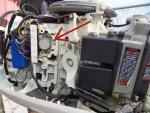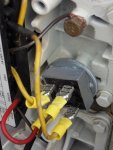Johnson 115HP model no. J115TLCTE (not sure the year, maybe someone could specify based on the model and pic below?)
Late last year I noticed the battery wasn't being charged anymore. Didn't think this would matter much as I could just charge it at home. But planning a 5 day camping/boating trip for next month with no access to AC, so this could be a real problem for us. Battery is used for my trolling motor during docking and to power the GPS and fish finder. So having a working charging system is now important.
Don't know much about these engines or what could have failed, thus here hoping for input. Posted a pic of a part I suspect could be the issue (indicated with a red arrow in the pic). No idea what it's called. If this is a potential candidate, is there a test I can perform? Have a digital multimetre I could use for Ohm, etc. If additional pics would make this helpful please let me know and I'll post more. Used to replacing alternators in cars but there's nothing here slightly resembling one, so please add detail when describing a part. Thanks.
Late last year I noticed the battery wasn't being charged anymore. Didn't think this would matter much as I could just charge it at home. But planning a 5 day camping/boating trip for next month with no access to AC, so this could be a real problem for us. Battery is used for my trolling motor during docking and to power the GPS and fish finder. So having a working charging system is now important.
Don't know much about these engines or what could have failed, thus here hoping for input. Posted a pic of a part I suspect could be the issue (indicated with a red arrow in the pic). No idea what it's called. If this is a potential candidate, is there a test I can perform? Have a digital multimetre I could use for Ohm, etc. If additional pics would make this helpful please let me know and I'll post more. Used to replacing alternators in cars but there's nothing here slightly resembling one, so please add detail when describing a part. Thanks.






















